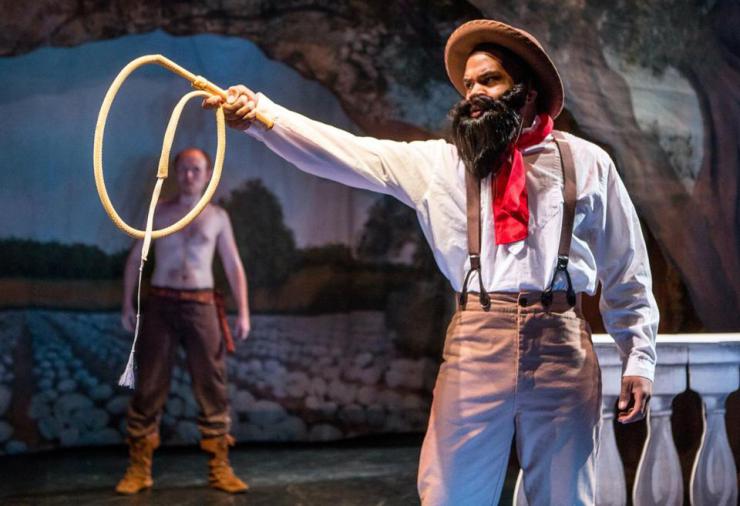The Dissonance of An Octoroon
Interactive forms of performance have placed audiences in a new relationship to the stories they are watching, where they are both spectator and participant. This series will explore the ways various artists and companies employ the tools of interactive theatre to complicate audiences’ individualized experiences and get them thinking about their place within a community.
Every so often, you attend a piece of theatre that re-affirms your beliefs about what art can be. I had such a pleasure last month when I saw Company One and ArtsEmerson’s production of An Octoroon by Branden Jacobs-Jenkins. The play is an adaptation of Dion Boucicault’s 1859 abolitionist melodrama retold through Jacobs-Jenkins eyes. The Writer, an African American, stepped into the drama playing the roles of both its male white protagonist and antagonist. The plot focused on Zoe, a young woman who is an octoroon (i.e. one-eighth African American), and how these two male characters fought to control the Louisiana plantation on which she lived and thus either free her or permanently enslave her.
Jacobs-Jenkins’ script is one of the very best I have encountered in a long time; it asks profound questions about the simultaneous malleability and rigidity of race, identity, and justice. But what made the play stand out so completely for me was the way it manipulated the audience’s position throughout its five-act structure.
Before the show began, a Company One staff member introduced us spectators to some of the conceits of melodrama. Spectators in the nineteenth century were typically very vocal, booing and hissing and cheering at turns in the plot. So this staff member encouraged us to be equally lively in our own responses. As I have said before, I enjoy interacting, and I was happy to participate in this way. It was an easy introduction to our role as not just viewers, but as a kind of moral authority.

On the night I saw the show, spectators had become comfortable vocally commenting on the action by the end of its second act. Come the third act, the first shift in the audience’s position occurred. The play’s villain, McClosky, had successfully thwarted efforts to save the plantation, and soon Zoe was placed on an auction block. Several audience members were randomly given cards with which they could bid on her as the characters onstage did the same. I was not one of those with a card, so I sat back and watched in discomfort as the price of Zoe’s life went higher and higher.
Suddenly reality and fantasy were clashing with each other. For the sake of the drama of the scene, the more spectators bid, the more tension it created as McClosky tried to outbid everyone. But we started to lose our place of moral authority by reducing a human life to price tag. This sensation was unsettling, yet still manageable. Due to the exaggerated acting of the company, the two-dimensionality of the scenic design and the tinny sound of the music, I felt I was still within a theatrical conceit. But the auction was only the first step.
In the climactic fourth act, our hero, George, found evidence that McClosky had killed a young slave boy who held a letter that would have saved the plantation. All of this was proven by a photograph that happened to be taken at that moment. George then rallied everyone present to hold an impromptu trial of McClosky.
At this point, the Writer broke out of character(s) to explain that in 1859 this scene hinged on audience still being fascinated by photography. Knowing that contemporary viewers would be unimpressed by this technology, the Writer set up a projector, and said he wanted to try something different. He began a slideshow of images from the twentieth century of public lynching. When these images began to roll, a well of emotion came over me that lasted until the next morning. I sat stunned as the Writer called on us, now cast as the crowd trying McClosky, to decide justice. Ultimately, McClosky was dragged off to be hanged.
My task as witness to this event was to wrestle with my ever-shifting position, and think about how I could solidify one in real life.
The sense of distance I had maintained in the auction scene now disappeared. After spending most of the night commenting on the moral indecencies of the plot from my safe space in the risers, I had slowly transformed into an active participant, taking justice into my own hands by calling for McClosky’s execution. But the images of lynching destroyed the notion that I had the moral high ground. I was living a contradiction. I was on the side of good, demanding a racist murderer be punished, but I was also a man in those photographs, smiling below the dangling feet of a dead African American. I was joyous over the white character dragged off to “justice,” but horrified it was a black actor playing the role. I was lost in a loop, feeling history repeating and repeating without hope of changing it.
The final act returned the spectators to a position of silence without agency. Zoe, unaware of what had happened, entered in the night and planned to commit suicide rather than be owned by McClosky. I felt impotent, unable to do anything anymore as this woman, fetishized by whites and deplored by the slaves on the plantation, went off to face her death.
While I felt wretched for the rest of the night, I also emerged from An Octoroon filled with hope. This production represented so much of what I have been talking about in this series. Audience members were given a clear contract at the beginning of the show, and their position was slowly shifted from act to act. The auction scene made us look at each other and think about how others were perceiving the show. The lynching images brought us to an emotional and intellectual tipping point, bringing us to the height of our agency before losing all of it in the final act. My task as witness to this event was to wrestle with my ever-shifting position, and think about how I could solidify one in real life.
Sometimes you are gifted with a reminder of why this art form matters. I had that moment, and I thank all the artists who made that happen. Please, let this world have more of the same.


Comments
The article is just the start of the conversation—we want to know what you think about this subject, too! HowlRound is a space for knowledge-sharing, and we welcome spirited, thoughtful, and on-topic dialogue. Find our full comments policy here